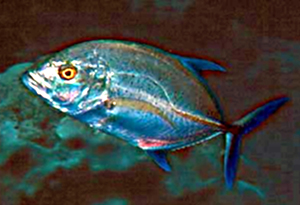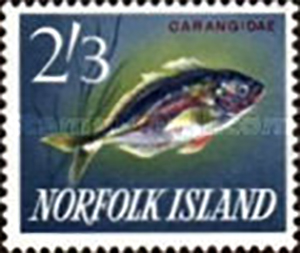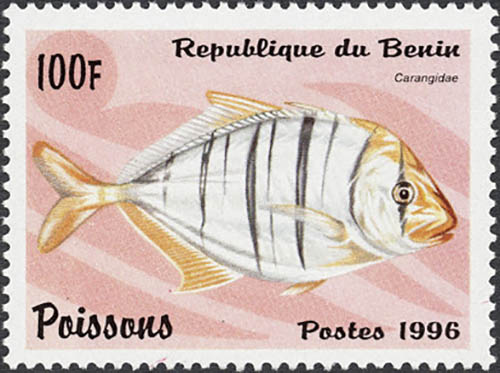Caranx sp.

Foto: Bryan Harry
(Da: fr.wikipedia.org)
Phylum: Chordata Haeckel, 1874
Subphylum: Vertebrata Lamarck J-B., 1801
Classe: Actinopterygii Klein, 1885
Ordine: Perciformes Bleeker, 1859
Famiglia: Carangidae Rafinesque, 1815
Genere: Caranx Lacepède, 18
Italiano: Carangio
English: Trevally
Français: Carangue
Español: Jurel
Specie e sottospecie
Il genere attualmente annovera le seguenti specie: Caranx bucculentus Alleyne and Macleay, 1877 - Caranx caballus Günther, 1868 - Caranx caninus Günther, 1867 - Caranx crysos Mitchill, 1815 - Caranx fischeri Smith-Vaniz & Carpenter, 2006 - Caranx heberi Bennett, 1830 - Caranx hippos Linnaeus, 1766 - Caranx ignobilis Forsskål, 1775 - Caranx latus Agassiz in Spix & Agassiz, 1831 - Caranx lugubris Poey, 1860 - Caranx melampygus Cuvier in Cuvier & Valenciennes, 183 - Caranx papuensis Alleyne & Macleay, 1877 - Caranx rhonchus Geoffroy Saint-Hilaire, 1817 - Caranx sansun Forsskål, 1775 -Caranx senegallus Cuvier in Cuvier & Valenciennes, 1833 - Caranx sexfasciatus Quoy & Gaimard, 1825 - Caranx tille Cuvier in Cuvier & Valenciennes, 1833 - Caranx vinctus Jordan & Gilbert, 1882.
Descrizione
Il primo rappresentante dei Caranx trovato nella documentazione fossile risale alla metà dell'Eocene, un periodo in cui apparvero molti lignaggi Perciformi moderni. I fossili sono costituiti principalmente da otoliti, con il materiale scheletrico osseo raramente conservato. Si trovano generalmente in depositi sedimentari di acque marine o salmastre poco profonde. Numerose specie estinte sono state definitivamente identificate e denominate scientificamente, tra cui: Caranx annectens Stinton, Eocene 1980, (Inghilterra) - Caranx gracilis dell'Oligocene (Dai Carpazi orientali rumeni) - Caranx carangopsis Steindachner, 1859 Cenozoico, (Austria) - Caranx daniltshenkoi Bannikov, Cenozoico 1990, (Russia) - Caranx exilis Rueckert-Uelkuemen, Cenozoico 1995 (Turchia) - Caranx extenuatus Stinton, 1980 Eocene (Inghilterra) - Caranx gigas Rueckert-Uelkuemen, Cenozoico 1995 (Turchia) - Caranx gracilis Kramberger, 1882 Oligocene-Miocene inferiore (Romania) - Caranx hagni Rueckert-Uelkuemen, 1995 Cenozoico (Turchia) - Caranx macoveii Pauca, 1929 Oligocene-Miocene inferiore (Romania) - Caranx petrodavae Simionescu, 1905 Oligocene-Miocene inferiore (Romania) - Caranx praelatus Stinton, 1980 Eocene (Inghilterra) - Caranx primaevus Eastman, 1904 Eocene (Italia) (può essere attribuibile al proprio genere Eastmanalepes) - Caranx quietus Bannikov, 1990 Cenozoico (Russia). Questi pesci hanno aspetto variabile ma hanno sempre un corpo ovale molto compresso lateralmente, occhio grande e bocca dotata di un vistoso osso sopramascellare. La linea laterale forma una brusca curva nella parte posteriore, a partire dalla quale è ricoperta di squame ingrandite (scudetti). Peduncolo caudale potente senza pinnule, pinna caudale ampia e falcata. Le pinne dorsali sono due, la prima corta con raggi spinosi, la seconda più lunga e simmetrica alla pinna anale. Le pinne pettorali sono grandi o molto grandi, appuntite.
Diffusione
I membri di questo genere si incontrano in tutti i mari caldi o temperati caldi. Nel mar Mediterraneo sono presenti 3 specie, non comuni in Italia: il Caranx hippos, o carango cavallo – il Caranx crysos, o carango dorato – il Caranx rhonchus, o carango ronco. Le abitudini di vita di questi pesci sono sempre pelagiche ma con modalità assai diverse tra le specie, alcune infatti sono costiere e frequentano anche le lagune coralline, mentre altre sono frequentano il mare aperto ed altre sono comuni solo ad alcune centinaia di metri di profondità.
Bibliografia
–Sepkoski, Jack (2002). "A compendium of fossil marine animal genera". Bulletins of American Paleontology. 364: 560.
–J. S. Nelson; T. C. Grande; M. V. H. Wilson (2016). Fishes of the World (5th ed.). Wiley. pp. 380-387.
–Reed, David L.; Carpenter, Kent E.; deGravelle, Martin J. (2002). "Molecular systematics of the Jacks (Perciformes: Carangidae) based on mitochondrial cytochrome b sequences using parsimony, likelihood, and Bayesian approaches". Molecular Phylogenetics and Evolution. USA: Elsevier Science. 23 (3): 513-524.
–Zhu, Shi-Hua; Wen-Juan Zing; Ji-Xing Zou; Yin-Chung Yang; Xi-Quan Shen (2007). "Molecular phylogenetic relationship of Carangidae based on the sequences of complete mitochondrial cytochrome b gene". Acta Zoologica Sinica. 53 (4): 641-650.
–Gushiken, S. (1988). "Phylogenetic relationships of the perciform genera of the family Carangidae". Japanese Journal of Ichthyology. 34 (4): 443-461.
–Hosese, D.F.; Bray, D.J.; Paxton, J.R.; Alen, G.R. (2007). Zoological Catalogue of Australia Vol. 35 (2) Fishes. Sydney: CSIRO. p. 1150.
–Gunn, John S. (1990). "A revision of selected genera of the family Carangidae (Pisces) from Australian waters" (PDF). Records of the Australian Museum Supplement. 12: 1-78.
–Froese, Rainer and Pauly, Daniel, eds. (2013). Species of Caranx in FishBase. February 2013 version.
–Stinton, F.C. (1980). "Fish otoliths from the English Eocene. Part. 4". Palaeontographical Society Monographs (London). 133 (558): 191-258.
–Smith-Vaniz, W.F.; K.E. Carpenter (2007). "Review of the crevalle jacks, Caranx hippos complex (Teleostei: Carangidae), with a description of a new species from West Africa" (PDF). Fishery Bulletin. 105 (2): 207-233.
–Bannikov, A.F. (1990). "Fossil carangids and apolectids of the USSR". Trudy Paleontologicheskogo Instituta. 244: 1-108.
–Rueckert-Uelkuemen, Neriman (1995). "Carangidae, Priacanthidae, Scorpaenidae, and Sparidae (Pisces) from the Sarmatian layers of Pinarhisar (Thrace, Turkey)". Mitteilungen der Bayerischen Staatssammlung für Paläontologie und historische Geologie. 35: 65-86.
–Constantin, P. (1998). "Oligocen-Lowemost Miocene Fossil Fish-Fauna (Teleosti)" (PDF). Geo-Eco-Marina. 4: 119-134. Retrieved 29 June 2012.
–Bannikov, A.F. (1984). "An Eocene genus of scad, subfamily Caranginae". Paleontologicheskii Zhurnal. 1984 (3): 133-135.
–Froese, Rainer and Pauly, Daniel, eds. (2008). Species of Caranx in FishBase. June 2008 version.
–Carpenter, Kent E.; Volker H. Niem, eds. (2001). FAO species identification guide for fishery purposes. The living marine resources of the Western Central Pacific. Volume 5. Bony fishes part 3 (Menidae to Pomacentridae) (PDF). Rome: FAO. p. 2684.
–Miller, Donald M. (1990). Ciguatera Seafood Toxins. CRC Press. pp. 8-9.

|
Data: 01/01/1962
Emissione: Ittiofauna Stato: Norfolk Island |
|---|

|
Data: 04/12/1996
Emissione: Ittiofauna Stato: Benin |
|---|